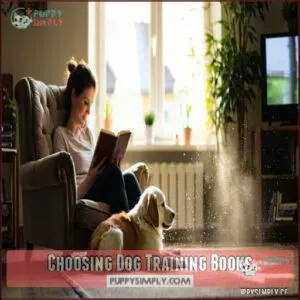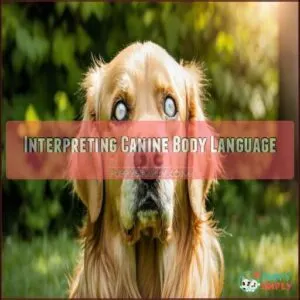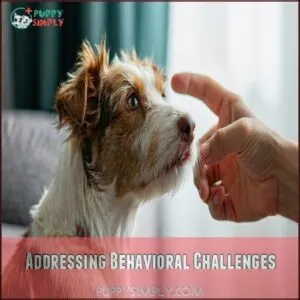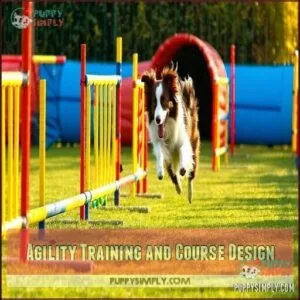This site is supported by our readers. We may earn a commission, at no cost to you, if you purchase through links.
 You’ll find the best dog training books focus on positive reinforcement techniques rather than outdated punishment methods.
You’ll find the best dog training books focus on positive reinforcement techniques rather than outdated punishment methods.
"Don’t Shoot the Dog" by Karen Pryor and "The Power of Positive Dog Training" by Pat Miller remain industry standards, while Sophia Yin’s "Perfect Puppy in 7 Days" offers quick results for new pet parents.
For specific issues, look to "Fired Up, Frantic, and Freaked Out" for anxiety or "Behavior Adjustment Training" for reactivity.
Choose books that match your training philosophy and provide clear, step-by-step instructions, as the right book isn’t just about commands—it’s about understanding how your four-legged friend actually thinks, using clear instructions and focusing on positive methods.
Table Of Contents
- Key Takeaways
- Choosing Dog Training Books
- Top 7 Dog Training Books
- Dog Training Methods
- Effective Training Techniques
- Specialized Dog Training
- Selecting Right Training Book
- Frequently Asked Questions (FAQs)
- Should you buy a dog training book?
- What are the best dog training books?
- What should a dog training book include?
- How do I find a good dog training book?
- Are dog training books trustworthy?
- Why should you read dog training books?
- What is the best dog training book on the market?
- What is the 3 second rule in dog training?
- What is the most successful dog training?
- What are the three C’s of dog training?
- Conclusion
Key Takeaways
- You’ll find the most effective dog training books focus on positive reinforcement techniques rather than outdated punishment methods, with classics like "Don’t Shoot the Dog" by Karen Pryor remaining industry standards.
- When choosing a dog training book, match it to your dog’s specific needs and your training goals, paying attention to the author’s credentials and whether they emphasize science-backed techniques.
- Look for books with clear instructions, visual aids, and logical organization that break training into manageable steps—clarity in presentation makes a significant difference in your training success.
- The best dog training resources address both basic obedience and specialized challenges like separation anxiety or reactivity, helping you build trust and effective communication with your dog.
Choosing Dog Training Books
Choosing the right dog training book can feel overwhelming, but it doesn’t have to be.
Focus on your dog’s needs, your goals, and methods that fit your style, and you’ll find a guide that sets you up for success.
Purpose and Specific Needs
Finding the right dog training book starts with understanding your dog’s age, breed traits, and unique needs.
Are you raising a high-energy puppy or taming a couch-loving senior?
Match training goals and behavioral issues with recommendations to guarantee a lifestyle fit.
Choosing puppy training books or dog training book reviews suited to your purpose saves time and frustration.
Training Philosophy
When picking dog training books, the training philosophy matters most.
Look for ethical considerations, like force-free methods and LIMA principles, which focus on positive reinforcement training.
A solid philosophy aligns with a dog’s perspective and has scientific backing.
Choose books that promote kind, effective dog training approaches, avoiding outdated techniques, and remember that training should build trust, not fear!
Review and Recommendations
When weighing dog training books, look for reviews tying book comparisons to real success stories.
Consider author expertise—are they seasoned trainers or popular voices? Value assessment is key; a solid dog training book offers practical advice and proven training effectiveness.
Reader feedback can highlight relatable tips or overlooked gems, making dog training book recommendations more trustworthy. A solid dog training book is one that provides proven training effectiveness, and by considering these factors, you can make a more informed decision.
Clarity and Presentation
A dog training book’s clarity and presentation make learning a breeze.
Look for these key features:
- Concise language—clear points trump fluff every time.
- Visual aids—charts or photos simplify tough concepts.
- Practical examples—real-life scenarios help apply lessons.
- Logical book structure—a well-organized flow keeps frustration at bay.
Stick to these tips, and your search for the best dog training book gets easier!
Updated Information
Great dog training books keep up with current research and evolving techniques.
Look for updated editions featuring modern tools, relevant statistics, and approaches grounded in today’s best practices.
Outdated advice can lead you astray, so check recent dog training book reviews.
Updated information guarantees the guides you choose reflect what actually works in the ever-changing world of canine behavior, with current research ensuring the most effective training methods.
Top 7 Dog Training Books
Finding the right dog training book can feel overwhelming, but the best ones make learning simple and effective.
Here are seven top picks that use proven methods to help you and your dog succeed.
1. Positive Dog Training Solve Behavior Problems
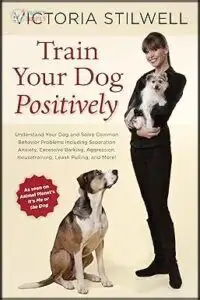
Sometimes, the simplest approach is the most effective, and that’s where positive dog training shines.
This method teaches your dog to love learning using rewards like treats, praise, or even a favorite toy.
It’s about solving behavior problems—think barking or chewing—by focusing on what your dog does right.
With clear, step-by-step guidance, it encourages trust and communication.
You’ll start noticing changes within weeks, and the best part? No harsh techniques, just positive vibes.
It’s training that takes patience but works wonders!
Best For: Dog owners looking for a gentle, proven way to address behavioral problems while strengthening their bond with their pet.
- Uses positive reinforcement to encourage good behavior.
- Suitable for all dog breeds and ages with customizable training plans.
- Step-by-step guides make it easy for beginners to start training.
- Requires commitment and consistency for best results.
- Results may vary depending on the dog’s temperament and history.
- High-value rewards must be timed perfectly to ensure effectiveness.
2. How to Speak Dog Mastering Canine Communication
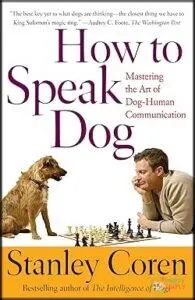
Ever wonder what your dog’s wagging tail or subtle yawn really means?
How to Speak Dog: Mastering Canine Communication dives into decoding your dog’s unique “language.”
This book helps you grasp body cues, vocalizations, and even scent-based signals, so you can truly “hear” what your pup is saying.
With practical exercises and fascinating insights, you’ll strengthen your bond and handle miscommunication like a pro.
Understanding your furry friend’s silent messages makes training smoother—and life together even more rewarding, making your dog’s world just got clearer with practical exercises and fascinating insights, and by strengthening your bond.
Best For: Dog owners, trainers, and enthusiasts who want to deeply understand canine communication and strengthen their bond with their dogs.
- Provides clear guidance on interpreting body language, vocalizations, and scent signals.
- Includes practical exercises and real-world case studies.
- Improves training effectiveness and reduces miscommunication.
- Requires consistent practice to fully grasp the concepts.
- Does not address every breed-specific communication trait in detail.
- Some behavioral issues may still need professional guidance.
3. Fun Dog Training For Kids
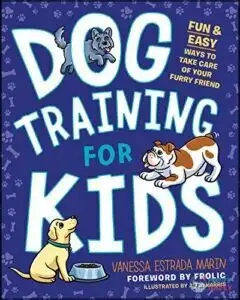
If you’ve ever wanted to get kids more involved in training the family dog, Dog Training for Kids makes it as easy as teaching a pup to sit.
This book blends clear instructions with fun tricks like “high five” and “roll over,” along with basic training tips for barking, potty training, and leash manners.
It’s packed with engaging games like obstacle courses and includes handy extras like sample schedules and dog-proofing advice.
Perfect for young trainers keen to bond with their furry friends and learn fun tricks like “high five”.
Best For: Families with kids aged 7 and up who want to train their dog while having fun and bonding.
- Clear instructions suitable for kids and first-time dog owners.
- Includes fun tricks, games, and activities for bonding.
- Handy extras like sample schedules and dog-proofing tips.
- Does not address biting or nipping behaviors.
- Small print may make the content harder to read.
- Limited guidance for advanced training techniques.
4. Training Supportive Service Dog Companions
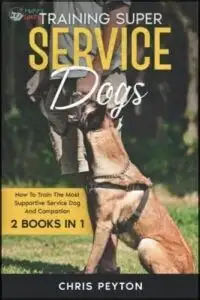
If you’re raising a service dog, you’ll need a book that’s more than just basic commands.
Service Dog Training Guide is a standout, offering step-by-step instructions designed to train a dependable companion.
With clear examples, you’ll learn how to teach tasks like mobility assistance or medical alerts.
Created for real-world scenarios, it guides you through public behavior and building trust.
It’s practical, easy to follow, and ideal for anyone committed to preparing a supportive, well-mannered service dog.
Best For: Individuals who want a practical, step-by-step guide to training a reliable and supportive service dog.
- Offers clear and easy-to-follow instructions for beginner and experienced trainers.
- Covers essential tasks like mobility assistance and medical alert training.
- Focuses on real-world scenarios for public behavior and trust-building.
- May not provide in-depth techniques for advanced or specialized service tasks.
- Lacks focus on alternative training philosophies beyond positive reinforcement.
- Limited guidance on selecting and assessing dogs for specific service roles.
5. Train Your Dog To Behave
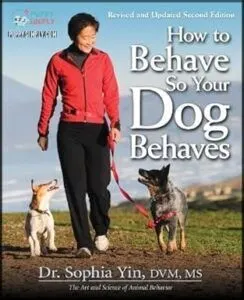
For a well-rounded approach to training, The Power of Positive Dog Training by Pat Miller and Don’t Shoot the Dog! by Karen Pryor are must-reads.
They show you how to use positive reinforcement to shape your dog’s behavior, making training less stressful and more rewarding.
These books teach foundational skills like sit, stay, and come, while addressing common challenges such as barking or chewing.
With clear guidance and proven techniques, they’re ideal for building trust and joy into your dog-human relationship.
Best For: Dog owners seeking an effective, science-based training program that fosters a strong bond with their pets.
- Uses positive reinforcement techniques for stress-free training.
- Covers both basic obedience and common behavioral issues.
- Customizable training plans with lifetime content updates.
- Requires commitment to consistent practice for best results.
- May need additional tools like treats or a clicker.
- Results can vary based on a dog’s temperament and history.
6. Understanding Dog Behavior Around Humans
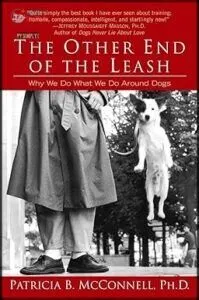
Understanding dog behavior around humans is like learning a secret language—it takes observation and patience.
Dogs communicate with tails, ears, and even yawns, showing everything from happiness to stress. Focusing on their body language, like a wagging tail or tucked ears, helps you avoid misunderstandings.
Direct eye contact can intimidate, so approach calmly to build trust. Remember, consistency is key—your actions speak louder than words.
Books like How to Speak Dog by Stanley Coren simplify this complex dance, making training smoother and more fun. Many owners struggle with excessive barking issues, highlighting the need for understanding and effective communication to address issues like excessive barking.
Best For: Dog owners who want to improve communication and strengthen their bond with their pets.
- Requires time and patience to fully implement communication skills.
- May not address breed-specific behaviors in detail.
- Relies heavily on human interpretation, which can vary.
- Helps decode canine body language, reducing stress and misunderstandings.
- Supports training with positive reinforcement for better interactions.
- Provides practical tips for creating a consistent and trusting relationship.
7. Training Crazy Dogs to Calmness
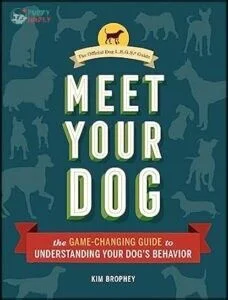
For highly energetic or reactive dogs, "Fired Up, Frantic, and Freaked Out: Training the Crazy Dog from Over the Top to Under Control" is your go-to guide.
This practical book offers scientifically-proven techniques to transform your bouncing bundle of energy into a calmer companion.
You’ll learn five effective calming techniques including Boundary Games and the Place command.
The author provides step-by-step instructions that require just 15-20 minutes of daily practice.
With consistent application, you can reduce reactive behaviors by up to 70% – turning what feels like chaos into peaceful coexistence with your four-legged friend.
Best For: Owners of highly energetic or reactive dogs looking for proven methods to promote calmness and improve behavior.
- Not ideal for dogs with severe aggression or medical issues.
- Long-term success needs consistent practice and routine integration.
- May require additional tools like treats or toys for best results.
- Uses positive reinforcement and scientifically-backed techniques.
- Requires only 15-20 minutes of daily commitment.
- Includes step-by-step guidance suitable for all breeds and ages.
Dog Training Methods
You’ll find various training approaches in today’s top dog books, from positive reinforcement that rewards good behavior to clicker training that helps your pup make clear connections.
The right method for your furry friend depends on their personality and your goals, just like how some kids learn better with stickers while others respond to extra playtime, which can be considered a form of positive reinforcement.
Positive Reinforcement Training
After exploring top training books, let’s look at what makes them work.
Positive reinforcement training stands as the gold standard in modern dog education.
When you reward good behavior with treats, praise, or play, you’re basically telling your dog "Do more of that!"
Proper reward timing and treat effectiveness are vital for shaping behavior.
The best dog training books emphasize LIMA principles (Least Intrusive, Minimally Aversive) while avoiding punishment in favor of celebration-worthy moments.
Negative Punishment and Positive Punishment
While positive reinforcement rewards good behavior, modern dog training books also explain two other methods.
Negative punishment involves removing something your dog wants when they misbehave.
Positive punishment adds something unpleasant to discourage unwanted behaviors.
When exploring punishment effectiveness in dog training books, remember:
- Negative punishment (turning away, ignoring) causes less stress than positive punishment
- Positive punishment often increases anxiety in dogs
- Most ethical considerations favor combining positive reinforcement with minimal negative punishment
These behavioral consequences shape your dog’s understanding without damaging your bond or causing fear, which is a key aspect of effective dog training and maintaining a healthy relationship with your dog, based on ethical considerations.
Clicker Training and Reward Systems
While harsh training methods can backfire, clicker training offers a gentler approach.
The click sound marks the exact moment your dog does something right, followed by a treat. Many top dog training books recommend varied treat types to keep your pup engaged.
You’ll learn shaping behavior through variable rewards and target training—small steps that build impressive skills over time. It’s reward-based training at its finest!
For clicker training supplies, check out the resources available.
Effective Training Techniques
You’ll find consistent practice with positive reinforcement is the secret to successful dog training, just like teaching a child to ride a bike requires patience and the right approach.
Good training books show you how to read your dog’s body language and build trust while giving you practical tools to address common behavior issues without causing stress or confusion, using good training.
Building Trust and Strong Bond
Trust forms the foundation of effective dog training.
Building a bond of trust is the cornerstone that transforms commands into willing cooperation.
The best dog training books emphasize building a strong dog-human bond through mutual respect and consistent communication.
You’ll learn how positive interactions during training and shared activities create an emotional connection your dog craves.
When your canine companion trusts you, they’re more willing to learn and follow your guidance, which transforms training from mere obedience into true canine companionship through a two-way street of understanding.
Interpreting Canine Body Language
Building a strong bond with your dog relies on your ability to understand what they’re saying without words.
Dogs constantly communicate through their body language. Watch for tail wags (direction matters!), ear position, and lip licking to gauge your dog’s mood.
"Whale eye," where you can see the whites of their eyes, often signals anxiety.
Many dog training books emphasize reading canine body language as the foundation of effective communication and training, highlighting the importance of effective communication.
Addressing Behavioral Challenges
Frustration often lies at the heart of behavioral challenges. When your dog shows aggression, anxiety, or destructive behaviors, the right dog training books offer proven solutions.
Look for guides that address reactivity modification through understanding canine body language. Fear management techniques should focus on gradual exposure and positive associations.
The best resources teach you to identify aggression triggers and implement effective, humane strategies for lasting behavior change. Addressing these issues often requires professional behavioral help for effective modification plans.
Specialized Dog Training
You’ll find essential guidance for specific canine challenges in books that address separation anxiety, agility training, and advanced obedience skills.
Whether your dog freezes when you grab your keys or you’re ready to teach impressive tricks, specialized training resources offer targeted solutions for your unique training goals.
Separation Anxiety and Fear-Based Issues
After mastering the basics with your dog, you’ll want resources for specific challenges.
Separation anxiety affects many dogs, especially those from shelters or with histories of abandonment. Look for books that explain anxiety triggers and fear-based reactions.
The best guides offer step-by-step behavior modification plans, calming techniques, and fear desensitization exercises. Many owners seek solutions for dog separation products to ease their pets’ distress.
Some recommend medication options for severe cases, but always suggest professional help when needed, as separation anxiety can be a significant issue.
Agility Training and Course Design
While helping fearful dogs requires patience, shifting your training focus to agility opens a world of fun challenges for both you and your pup.
"Agility Right from the Start" by Eva Bertilsson and Emelie Johnson Vegh stands out among dog training books for breaking down complex course sequencing and tunnel strategies.
You’ll learn proper jump heights, weave pole techniques, and understand contact zones—all essential elements of dog sports that build confidence through physical activity.
Many resources are available for those interested in dog agility guides for further learning and improvement in agility training and fun challenges.
Advanced Obedience and Trick Training
While agility puts your dog’s physical skills to the test, advanced obedience takes their mental abilities to new heights.
The best dog training books for trick sequencing and complex commands show you how to build impressive routines using prop integration.
You’ll find step-by-step guides for distance control exercises that challenge even smart breeds.
Look for problem-solving approaches that turn advanced dog training from frustrating to fun. Consider that many owners find success with positive reinforcement methods.
Selecting Right Training Book
You’ll find the perfect training guide by matching a book’s methods to your dog’s personality and your training goals.
Look for authors with certified credentials who emphasize positive reinforcement techniques, as these books often provide clearer instructions and more effective results, which can be considered a key aspect of effective training.
Reviewing Training Philosophy and Methods
When choosing dog training books, take time to examine the training philosophy they promote.
Look for authors who embrace LIMA principles (Least Intrusive, Minimally Aversive) and have scientific backing for their methods.
The best dog training books clearly explain reinforcement schedules and emphasize training consistency.
Avoid guides pushing dominance theory or punishment-based techniques.
Instead, seek ethical considerations throughout the book that prioritize your dog’s welfare and psychological health.
Positive reinforcement, supported by scientific studies, is considered the most effective method.
Assessing Clarity and Presentation of Content
Many dog training books overwhelm readers with confusing instructions.
When evaluating clarity and presentation in dog training books, look for:
- Visual aids that demonstrate proper technique and body positioning
- Limited jargon usage with clear definitions when technical terms appear
- Step-by-step guides broken into manageable chunks
- Real-life examples that apply concepts to everyday situations
Content organization matters too—chapters should flow logically, making it easy to find specific solutions when you need them, and should have clear definitions, step-by-step guides, and real-life examples to enhance understanding.
Considering Updated Information and Research
Frequently, dog training books become outdated as new research emerges.
Always check publication dates when selecting resources. The most valuable books incorporate recent behavioral science studies and evolving methodologies in canine cognition.
Look for references to updated information on training technology and cognitive advancements. Authors who cite current dog training science demonstrate their commitment to evidence-based methods rather than relying on outdated techniques that might be ineffective or harmful, which underscores the importance of recent behavioral science.
Frequently Asked Questions (FAQs)
Should you buy a dog training book?
Yes, you should buy a dog training book.
They provide consistent, science-based methods you can reference anytime.
A good training book becomes your go-to resource when your pup’s behavior puzzles you.
What are the best dog training books?
The top dog training books include "The Power of Positive Dog Training" by Pat Miller and "Don’t Shoot the Dog!" by Karen Pryor.
Both emphasize positive reinforcement methods that you’ll find effective and humane.
What should a dog training book include?
Looking for the perfect training companion for your pup?
A good dog training book should include positive reinforcement techniques, step-by-step instructions, troubleshooting tips, and clear explanations of dog behavior and communication.
How do I find a good dog training book?
Look for books by certified trainers like Pat Miller or Karen Pryor that emphasize positive reinforcement.
Check for step-by-step instructions, clear explanations, and practical tips that match your dog’s specific training needs.
Are dog training books trustworthy?
Like choosing a lighthouse in a foggy harbor, you’ll find trustworthy dog training books by selecting those written by certified trainers.
They emphasize positive reinforcement methods and base their techniques on current behavioral science.
Why should you read dog training books?
You’ll gain science-based knowledge from experts who’ve worked with thousands of dogs.
They’ll help you understand your pup’s behavior, develop effective training techniques, and avoid common mistakes that can slow your progress, which includes gaining science-based knowledge and understanding your pup’s behavior.
What is the best dog training book on the market?
The Power of Positive Dog Training by Pat Miller is your best choice.
It offers a practical six-week program focusing on impulse control through positive reinforcement methods backed by 40+ years of expert experience.
What is the 3 second rule in dog training?
You’ll want to pet a dog for only 3 seconds, then pause. If they nudge you or lean in, continue petting. If they move away, they’re saying "no thanks.
What is the most successful dog training?
Positive reinforcement training is the most successful approach for dogs.
You’ll see better results when you reward good behavior with treats or praise rather than punishing mistakes.
It builds trust and lasting skills.
What are the three C’s of dog training?
Ever wondered what makes training truly stick?
The three C’s of dog training are Criteria (clear expectations), Consequences (rewards or corrections), and Consistency (being reliable in your approach).
You’ll see faster results with these fundamentals.
Conclusion
Finding the right dog training book is like finding a key that reveals your pup’s potential.
Remember, the best dog training books align with positive reinforcement methods and your specific needs.
Whether you’re dealing with puppy basics or complex behaviors, these seven guides offer practical solutions.
You’ll build a stronger bond with your furry friend while establishing clear communication.
Trust your instincts and don’t be afraid to try different approaches until you find what works for both of you, using your instincts as a guide.

